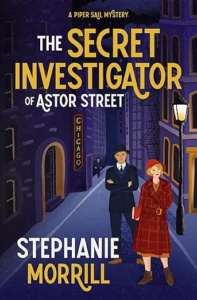The Secret Investigator of Astor Street (A Piper Sail Mystery #2)
Stephanie Morrill
Blink YA
Published August 5, 2025
Amazon | Bookshop | Goodreads
About The Secret Investigator of Astor Street
After high school graduation, Piper Sail isn’t quite sure what her future holds—until a possible murder case lands in her lap. Filled with both the glitz and glamor of high society and the dark mafia underbelly of 1920s Chicago, The Secret Investigator of Astor Street is perfect for fans of Agatha Christie and Maureen Johnson.
Piper Sail knows what she to become a detective. After all, she already solved the case of her missing best friend, and there’s no shortage of crime in 1920s Chicago. But for an eighteen-year-old society girl—even one who’s currently dating a police investigator—it simply isn’t done.
That is, until a girl asks her to dig into her brother’s recent death. The police ruled it a suicide, but she’s convinced it was murder. And she wants Piper to help her prove it.
In this companion to The Lost Girl of Astor Street, Piper once again grabs her notebook and plunges into the underworld of mafia-controlled Chicago. But she’ll need all her wits and courage if she wants to become The Secret Investigator of Astor Street.
My Review
I really enjoy Stephanie Morrill’s writing, so it was a no-brainer for me to read this book. If Piper Sail and Astor Street seem familiar to you, it’s because of The Lost Girl of Astor Street, the first book in which we meet Piper and follow her as she unravels the mystery of her best friend’s disappearance. That book was published in 2017, so it’s very possible you hadn’t heard of or remembered the book, either. (If so, the good news is that now you have two new mysteries to read.)
This story is set in 1920s Chicago. Piper has graduated from school, and her family expects her to enroll in college and/or find a prospective husband and start a family. The last thing Piper wants to do is have children, and she’s not ready to settle down. She has some doubts about the direction of her current relationship with Mariano, a detective who helped her in the first book.
I loved the way the story explored Piper’s questions about her direction for her life. She knows she doesn’t want to have kids. She isn’t ready to get married. But how can a young woman work as a private investigator? It’s not something that’s done. Whose permission does she need? How will anyone ever take her seriously?
The story makes space for Piper to explore these questions as her investigation into a supposed suicide unfolds. The balance between this theme and the mystery is perfectly done. We get a deeper understanding of Piper and follow her character development, but it never slows down the narrative.
Conclusion
If you enjoy historical mysteries, put this one on your list. I hope that this book marks a revival of the Piper Sail Mysteries as a series. The ending definitely leaves room for a new story.
Content Notes
Recommended for Ages 12 up.
Profanity/Crude Language Content
None.
Romance/Sexual Content
Kissing.
Spiritual Content
Reference to last rites (based on Catholic beliefs). I think there’s a brief reference to Piper noting that Mariano is Catholic, though she attends a different church.
Violent Content
Situations of peril. References to suicide. (Not shown on scene.) References to murder.
Drug Content
None.
Note: This post contains affiliate links, which do not cost you anything to use but help support this blog. I received a free copy of this book in exchange for my honest review. All opinions are my own.
